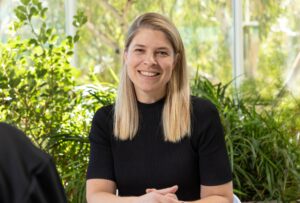
New lines of communication between researchers and clinicians are being developed through a key joint-appointment that is stimulating fresh ways to examine and improve aged care.
Professor Kate Laver’s position as the first joint-appointment between Flinders University’s Caring Futures Institute and SALHN’s Division of Rehabilitation, Aged and Palliative Care represents a new type of collaboration that is bringing health teams together in new ways.

“It aligns clearly with the Caring Future Institute’s vision of bringing together clinical practice, teaching and research – and this benefits the university through connecting more clinicians with the work our researchers are engaged in,” explains Professor Laver.
“The lines of communication are more open, so that we all really understand the core of the issues. It starts new conversations and builds a broader understanding of these issues so that we can move forward with focused research and implement strategies that will help improve aged care.”
She believes more diverse project teams and collaborations promote fresh outcomes through providing closer connections between clinicians and researchers.
“It represents the strengthening of crucial partnerships to secure future funding, and building collaborations that will ensure further developments in this crucial area of aged care reforms.”
It also alerts researchers to the primary concerns of clinicians, many which come as a surprise to researchers and can initiate new research paths. “We are learning first-hand about their critical concerns, and some of these things are being brought into my field of vision for the first time. It directs us to research work that is clinically relevant.”
As an example, Professor Laver is leading a collaboration between trauma teams and geriatricians who have specific expertise in caring for older people, to investigate the high prevalence of “silver trauma”, which is the high incidence of older people injured after falling from standing height.
“When we hear the word trauma associated with accidents, we tend to think of dramatic incidents, such as car accidents or falling from an elevated height, but the highest number of people presenting to coming to hospitals with trauma injuries are older people who have had falls from standing height,” says Professor Laver.
“It’s harder for an older person to recover from these traumas. They have fragile bones, they suffer deep bruising more easily, and the physical trauma they suffer can also have a profound psychological effect and change that person’s trajectory of ageing. They can lose confidence, feel more vulnerable, start to relinquish activities and become less independent.
“Often, these people are not staying in hospital care for very long, but they can have persistent pain issues that prevent their full rehabilitation. We want to introduce measures that can get them back to as close to 100% as possible.”
Having conducted workshops on “silver trauma” through 2024, with results set to be published soon in leading journals, the CFI team is recruiting research participants throughout 2025, with findings to be reported in early 2026. The results will influence the introduction of a new patient navigation system and increased support for older people once they return home from hospital after such a fall trauma.
Further benefits of growing collaboration between clinicians and researchers can be found in the CFI team’s creation of educational models for Occupational Therapists working in aged care, which will be issued in the next few months.
“We are working with Occupational Therapy Australia to help therapists who find themselves introduced to work in aged care environments for the first time, and if they are not so confident in that new setting, this new resource helps to fully inform them. It puts the very latest research into teaching models, and will help develop broader knowledge and skills.”
Providing such strong and focused resources that meet the demands of the aged care industry underlines the strength of CFI’s occupational therapy research team and the collective experience in aged care research.

